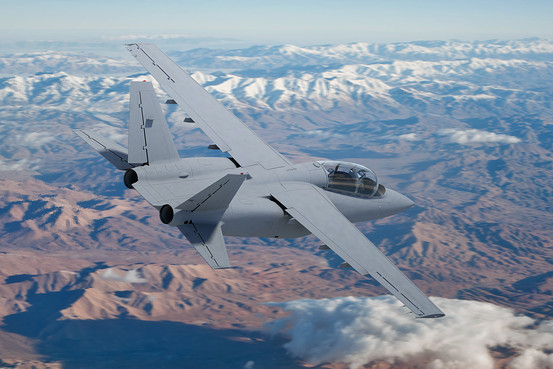Manticore
RETIRED MOD

- Joined
- Jan 18, 2009
- Messages
- 10,115
- Reaction score
- 114
- Country
- Location
Textron Inc. struck first blood Monday with its plan for an “affordable” fighter jet, as senior U.S. Air Force leaders gathered for their annual gabfest at a resort near Washington DC.

The maker of Cessna planes, Bell helicopters and, less threateningly, E-Z-Go golf carts only started work on the Scorpion reconnaissance and attack aircraft last year, and is targeting a first flight before the end of 2013.
Affordability is the new mantra for military leaders, with the Pentagon laboring under a fifth year of budget cuts and the blunt-force trauma of sequestration – the 10% across-the-board spending trim that came into force at the end of March.
“The Scorpion is designed to accommodate the increasingly stringent budget constraints of the U.S. Department of Defense and U.S. partner nations,” said Textron in a statement, ahead of Monday’s launch event with Chief Executive Scott Donnelly.
Textron isn’t disclosing the sticker price for the Scorpion, though a spokesman said it will be “multiple times lower [to buy and fly] than most of the best-known, modern twin-jet strike aircraft.”
The Scorpion isn’t aimed at the deluxe end of the $16 billion-a-year global fighter jet market, where a shiny Lockheed Martin Corp.LMT -0.61% F-35 will set you back more than $100 million, or would if its maker can keep costs in check.
However, there’s still plenty of demand out there from countries with limited budgets looking to replace aging U.S. and Russian-built jets.
Textron’s Scorpion fits the austere mantle of the annual USAF Air and Space Conference at National Harbor in Maryland, with talk of budget constraints and potential cuts to entire aircraft programs.
“We are in a classic inter-war defense drawdown, even before the war ends,” said Eric Fanning, the Acting Secretary of the Air Force, just before cutting the ribbon to open the show.
The secretary talked of focusing on what’s “affordable and sustainable”, a challenge when the service retains a long shopping list that includes the F-35, a new jet trainer and a new long-range bomber.
Textron has form in targeting air force bargain hunters, offering its Cessna 208B Caravan turboprop for the same reconnaissance and light-attack role envisaged for the Scorpion, which shares its name with a 1950s-vintage fighter built for the USAF by an ancestor of Northrop Grumman Corp.NOC -0.52%
Movie buffs might also recognize another Scorpion, the gunship that blew up everything in sight in James Cameron’s blockbuster, Avatar, and which looks suspiciously like a jazzed-up V-22, the tilt-rotor aircraft built by a joint venture between Boeing Co. and, as it happens, Textron. Introducing the Scorpion: The Budget-Priced American Fighter Jet - Corporate Intelligence - WSJ

The maker of Cessna planes, Bell helicopters and, less threateningly, E-Z-Go golf carts only started work on the Scorpion reconnaissance and attack aircraft last year, and is targeting a first flight before the end of 2013.
Affordability is the new mantra for military leaders, with the Pentagon laboring under a fifth year of budget cuts and the blunt-force trauma of sequestration – the 10% across-the-board spending trim that came into force at the end of March.
“The Scorpion is designed to accommodate the increasingly stringent budget constraints of the U.S. Department of Defense and U.S. partner nations,” said Textron in a statement, ahead of Monday’s launch event with Chief Executive Scott Donnelly.
Textron isn’t disclosing the sticker price for the Scorpion, though a spokesman said it will be “multiple times lower [to buy and fly] than most of the best-known, modern twin-jet strike aircraft.”
The Scorpion isn’t aimed at the deluxe end of the $16 billion-a-year global fighter jet market, where a shiny Lockheed Martin Corp.LMT -0.61% F-35 will set you back more than $100 million, or would if its maker can keep costs in check.
However, there’s still plenty of demand out there from countries with limited budgets looking to replace aging U.S. and Russian-built jets.
Textron’s Scorpion fits the austere mantle of the annual USAF Air and Space Conference at National Harbor in Maryland, with talk of budget constraints and potential cuts to entire aircraft programs.
“We are in a classic inter-war defense drawdown, even before the war ends,” said Eric Fanning, the Acting Secretary of the Air Force, just before cutting the ribbon to open the show.
The secretary talked of focusing on what’s “affordable and sustainable”, a challenge when the service retains a long shopping list that includes the F-35, a new jet trainer and a new long-range bomber.
Textron has form in targeting air force bargain hunters, offering its Cessna 208B Caravan turboprop for the same reconnaissance and light-attack role envisaged for the Scorpion, which shares its name with a 1950s-vintage fighter built for the USAF by an ancestor of Northrop Grumman Corp.NOC -0.52%
Movie buffs might also recognize another Scorpion, the gunship that blew up everything in sight in James Cameron’s blockbuster, Avatar, and which looks suspiciously like a jazzed-up V-22, the tilt-rotor aircraft built by a joint venture between Boeing Co. and, as it happens, Textron. Introducing the Scorpion: The Budget-Priced American Fighter Jet - Corporate Intelligence - WSJ








